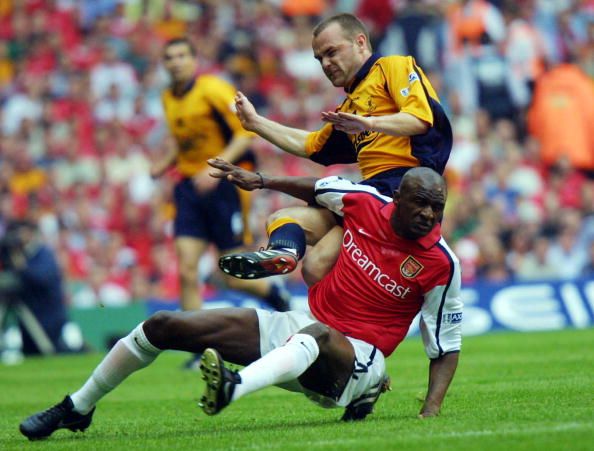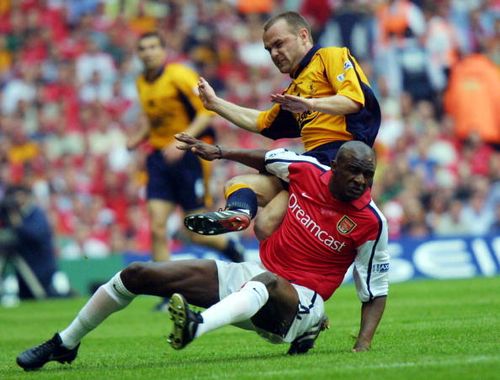
What happened to the traditional holding midfielder?

A defensive midfielder often brings an image of a cynical, rash tackler who often brings displeasure by stopping an attacking move, but yet is an invaluable asset to a team. They’re the missing jigsaw piece between the defense and the attack, and often tend to start attacks with the ball at their feet. Victory in a game often leads to praises being launched at the resolute defense or the ruthless attack, overshadowing the invaluable performance by these midfielders at the center of the park. Every successful team at its prime had a certain ‘number 4′ in their team sheet. Makalele with Real Madrid and Chelsea, Patrick Vieira at Arsenal, Roy Keane at Manchester United, Van Bommel at Bayern Munich, Cambiasso at Inter Milan, etc.
Football, of late, has been dominated by tricksters. Skilled with quick feet, Neymar, Ronaldo, Messi, and Iniesta to name a few, have hogged the limelight for their team’s success.
I’d hold a bet with you for this. Conduct a survey with 100 young, budding footballers out there, and not one would tell you,
“I wish to be the next Vieira” or “I wish to be the next Essien”.
Indeed, the holding midfielder is not the most attractive role on the pitch, but it’s a necessity.
Hard work, tireless running, contributing to BOTH attack and defense, providing skillful assists, and breaking the attacks of the opposition are all integrals of the skill-set that a DM would possess.
Of late, the traditional holding midfielder seems to be rare.What has happened to him?
In this article, we shall try to find an answer to this question.
Rewind to the 1930s, and the Italian football team was at its very best, bagging the 1934 and the 1938 World Cups. The formation that Vittorio Pozzo used was a flat formation of 2-3-2-3. Andreolo held the ‘center halfback’ position and stamped his authority on the game, with his runs contributing to the attack, while his nosy interceptions would douse the opposition’s attacks. Pep Guardiola restructed this formation to give his famous diamond formation, something that was an integral part of the recent success of the Catalan club.
In 1958, the Brazilian national team bagged the World Cup, adopting the very famous 4-2-4 formation.
This formation was much suited to Brazil’s fluent play. Closely observing the system would lead to a better understanding of the formation. The concept behind the formation was to have ’6 forwards and 6 defenders’. This formation tested the resilience and the energy of the two holding midfielders, who were made to move from box-to-box. The effectiveness of the midfielders proved to be the key to the success of this formation. After Brazil’s World Cup win, this formation gained popularity.
Modern football has diminished the role of a holding midfielder to a great extent. The game nowadays demands pace and ruthless attacking.
A look at a few modern formations would explain this anomaly. Starting with the traditional 4-4-2.
The 4-4-2 system was extensively used by AC Milan during their successful 90s under Fabio Capello. This formation was to cater to the needs of the forwards, playmakers stamped their authority on the game by largely contributing in the attack, while this system was often under severe criticism as it tended to put the back four under pressure and leave them vulnerable on counter-attacks.
Then came the 4-4-1-1, a formation that gave rise to the ‘False 9′ , again limiting the role of a DM to a large extent.
The game nowadays demands fast-free flowing football, attack on the break, and a classic DM is a rarity these days.
Look around the yesteryears, and names like Vieira, Essien, Scholes, Xavi, Xabi Alonso, Schweinsteiger, Carrick, Danny Murphy and Steven Gerrard at their prime were the backbone of their respective teams, and often the reason for their victorious conquests.
Looking at the current crop of holding midfielders, and the likes of Kevin Strootman and Khedira stand out in a rather meek department.

Footballers of the modern era seek fame and fortune, want to be the face of brands, and want to earn truckloads of cash. The modern footballer is selfish, and puts personal gains before his teams needs.
Loyalty, commitment, and a composed nature define the character of a DM, something which seems to be a little tough to grasp to the youth of today. To them, goals are all that matter, but they fail to realize that the beautiful game of football is a team game, a game that is based on the chemistry of all 11 players on the pitch.
Personal accolades such as Ballon d’Ors have been awarded to natural goal-scorers, often turning a blind eye towards the invaluable contribution of the tireless midfielders.
The trend looks set to continue, as the number of traditional holding midfielders seem to be on a decline. Build-up play is fast being replaced by sitting deep, and going on the counter when provided with the opportunity.
But based on past evidence, numerous successes have all pointed to the importance of the defensive midfielder, and the teams that are at the top of their respective leagues today; Barcelona, Manchester United, Bayern Munich; all have a functional holding midfielder.
DISCLAIMER – This article is purely opinion-based, and differences of opinions might prevail.